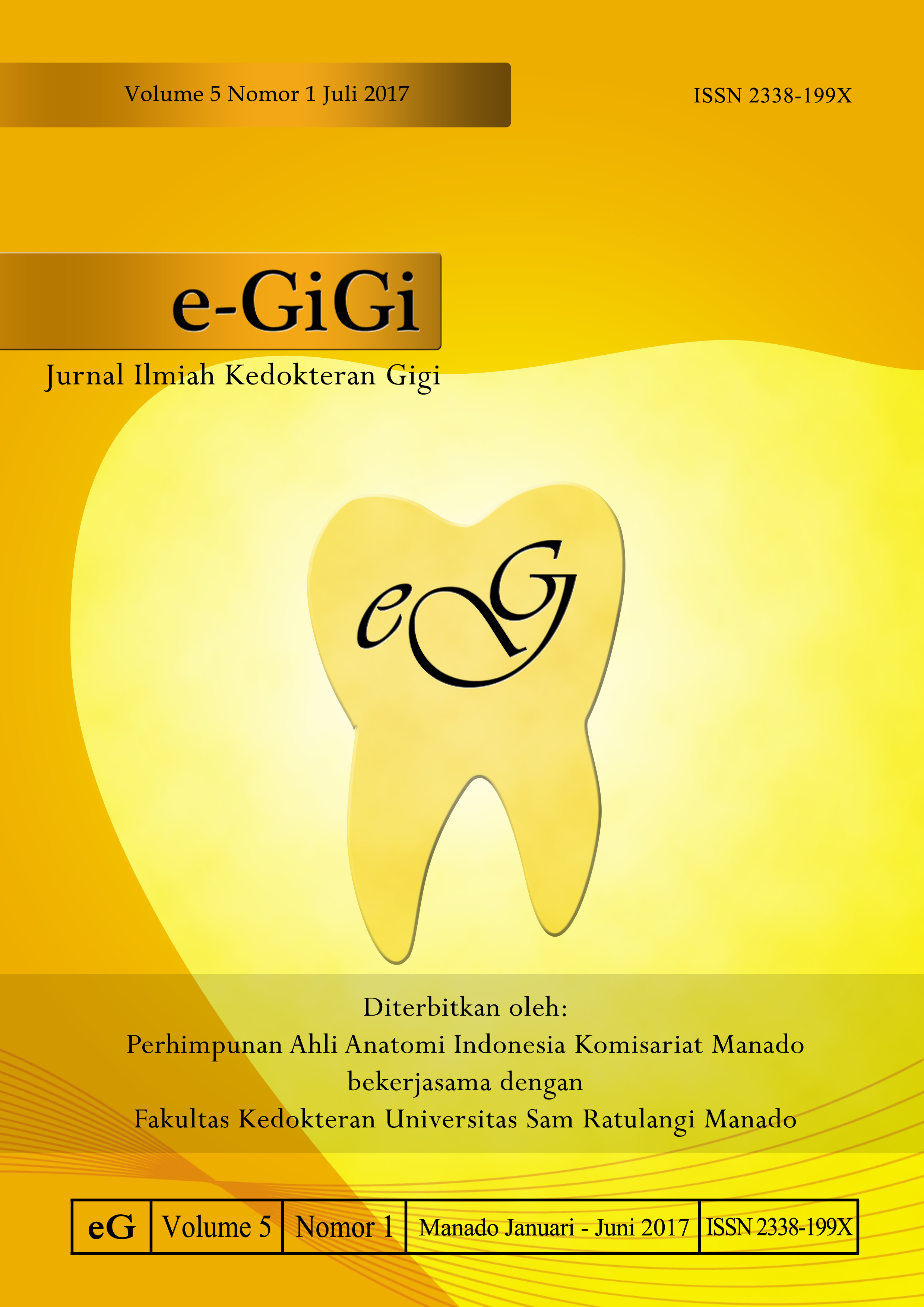Uji kekuatan transversal resin akrilik polimerisasi panas yang direndam dalam larutan cuka aren
DOI:
https://doi.org/10.35790/eg.5.1.2017.14771Abstract
Abstract: Acrylic resin is a material used for denture base frequently used in field dentistry. One characteristic of an acrylic resin is its strength against pressure. Strength is needed in a denture withstand the force from chewing received by the denture. The strength of a denture base material can be affected by the user’s habit of eating acidic food and beverages. Palm vinegar is an acidic kitchen ingredient obtained from the fermentation of palm sap and is usually used in North Sulawesi’s snack called gohu which is widely consumed by the population. This study was aimed to determine the transverse strength of an acrylic resin plate after being soaked in a palm vinegar solution. This was a laboratory study with a post-test control group design. There were 24 samples distributed in one control group and three treament groups. The samples were immersed for 5 and 10 days in the palm vinegar solution. The transverse test used a Universal Testing Machine. The results showed that after 5 days, the average transverse strength of acrylic resin plate was 94 N/mm2 in the less acidic palm vinegar solution; 88.3 N/mm2 in the acidic solution; and 80 N/mm2 in the highly acidic solution. After 10 days the average transverse of acrylic resin plate was 89.3 N/mm2 in the less acidic palm vinegar solution; 87.7 N/mm2 in the acidic solution, 46,3 N/mm2 in the high acidic solution. Conclusions: The higher the concentration levels of palm vinegar in the solution, the lower the transverse strength of acrylic resin.
Keywords: acrylic resin, palm vinegar solution, transverse strength
Â
Abstrak: Resin akrilik merupakan bahan basis gigi tiruan yang sudah sering dipakai di bidang kedokteran gigi. Salah satu sifat resin akrilik ialah kuat terhadap tekanan. Kekuatan basis dibutuhkan antara lain untuk menahan kekuatan daya kunyah yang diterima oleh gigi tiruan. Kekuatan bahan basis gigi tiruan dapat dipengaruhi oleh kebiasaan pengguna gigi tiruan dalam mengonsumsi makanan dan minuman bersifat asam. Cuka aren ialah salah satu bahan dapur yang bersifat asam yang didapat dari hasil fermentasi nira aren dan biasanya dipakai dalam jajanan tradisional khas Sulawesi Utara yakni gohu. Jajanan tersebut banyak dikonsumsi oleh masyarakat Sulawesi Utara. Penelitian ini bertujuan untuk mengetahui kekuatan transversal plat resin akrilik setelah direndam dalam larutan cuka aren. Jenis penelitian ialah laboratorik dengan post-test control group design. Sampel penelitian sebanyak 24 buah plat resin akrilik yang didistribusikan dalam 1 kelompok kontrol dan 3 kelompok perlakuan. Perendaman plat tersebut dilakukan selama 5 dan 10 hari. Uji kekuatan transversal dilakukan menggunakan alat Universal Testing Machine. Hasil penelitian mendapatkan setelah 5 hari perendaman dalam larutan cuka aren kurang asam rerata kekuatan transversal plat resin akrilik sebesar 94 N/mm2; sebesar 88,3 N/mm2 dalam larutan asam; dan sebesar 80 N/mm2 dalam larutan sangat asam. Setelah 10 hari perendaman dalam larutan cuka aren kurang asam rerata kekuatan transversal plat resin akrilik sebesar 89,3 N/mm2 sebesar 87,7 N/mm2 dalam larutan asam dan sebesar 46,3 N/mm2 dalam larutan sangat asam. Simpulan: Semakin tinggi kadar konsentrasi keasaman larutan cuka aren, semakin rendah kekuatan transversal resin akrilik.
Kata kunci: resin akrilik, larutan cuka aren, kekuatan transversal
Downloads
How to Cite
Issue
Section
License
COPYRIGHT
Authors who publish with this journal agree to the following terms:
Authors hold their copyright and grant this journal the privilege of first publication, with the work simultaneously licensed under a Creative Commons Attribution License that permits others to impart the work with an acknowledgment of the work's origin and initial publication by this journal.
Authors can enter into separate or additional contractual arrangements for the non-exclusive distribution of the journal's published version of the work (for example, post it to an institutional repository or publish it in a book), with an acknowledgment of its underlying publication in this journal.
Authors are permitted and encouraged to post their work online (for example, in institutional repositories or on their website) as it can lead to productive exchanges, as well as earlier and greater citation of the published work (See The Effect of Open Access).






